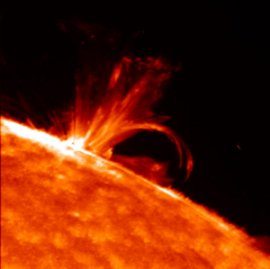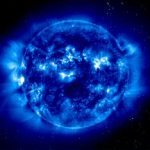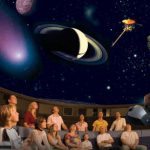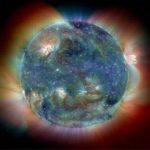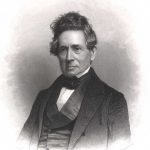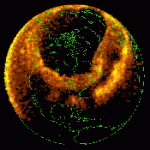This is a growing collection of major space weather events in history. This page contains a brief paragraph of the main effects of each solar storm, and a link to an archive of articles written about each storm that you can find in a variety of newspapers and magazines during the time of the storm. These accounts are a rich source of information about how each storm affected various technologies, and captivated the general public. Currently [August 15 , 2005], the archive includes 306 articles.
August 28, 1859 – The Superstorm. – This storm was observed world-wide and is, historically, one of the greatest events recorded in the last 150 years. Extensive eyewitness accounts and scientific studies, telegraph disturbances and the unique sighting of a spectacular solar flare make this event one of the most interesting solar storms to read about. [Newspaper Archive]
December 14, 1862 – The Civil War Aurora – This aurora was seen by Civil War soldiers in Fredericksberg Virginia. According to a letter by Milo Grow "There was a brilliant exhibition of Aurora Borealis soon after dark last night. For half an hour it shows very brilliantly reaching to the mid heavens in colors of yellow and red. " And in the David Ballenger letters "On the night of the second day of the battle there was a singular appearance in the elements, the most singular that I ever saw in my life. Some said it was an Aurora Borealis, or Northern Light, but if it was it was a little different from any I ever saw before. It rose on the side of the enemy and came up very near parallel with our line of battle, and right over us. It turned as red as blood, but when it commenced rising it looked more like the appearance of the moon rising than anything else I know to compare it to" (1862 December 23). " And by John W. Thompson, Jr. "Louisiana sent those famous cosmopolitan Zouaves called the Louisiana Tigers, and there were Florida troops who, undismayed in fire, stampeded the night after Fredericksburg, when the Aurora Borealis snapped and crackled over that field of the frozen dead hard by the Rappahannock …" And also in 1905 by Elizabeth Lyle Saxon in A Southern Woman’s War Time Reminiscenses " It was near this time that the wonderful spectacle of the Aurora Borealis was seen in the Gulf States. The whole sky was a ruddy glow as if from an enormous conflagration, but marked by the darting rays peculiar to the Northern light. It caused much surprise, and aroused the fears even of those far from superstitious. I remember an intelligent old Scotch lady said to me, "Oh, child, it is a terrible omen; such lights never burn, save for kings’ and heroes’ deaths."
October 14, 1870 – Aurora last night: Its remarkable brilliancy [New York Times, October 15, 1870, p.5].
October 24, 1870 – Cleveland and Cincinnati see a ‘splendid’ aurora. Widely observed throughout the country, the aurora lasted two days. Various scientific causes are mentioned, with quotes by Prof. Olmstead. [New York Times, October 27, 1870 p. 4]. Magnetic disturbances were recorded at the Melbourne Observatory in Australia, and found to occur at the same time as magnetic disturbances in northern observatories. [Harpers Weekly, 1871, issue 09/16]. An auroral display [New York Times, October 25, p.1]
February 4-5, 1872 – An aurora was seen from Paris with rays that stretched to the zenith. It was not reported to be as spectacular as the ‘blood red’ aurora seen in October 1870. [New York Times, February 29, 1872, p. 2]. It was also observed from Havana, Cuba and was widely interpreted to be an omen of the end of the world. [New York Times, February 17, 1872, p. 2]
August 18, 1872 – It was called ‘the most remarkable auroral display that has occurred within the memory of the present generation." [New York Times, August 18, 1872, p. 4].
May 28, 1877 – It was observed as an arch that moved halfway to the zenith from New York City. Following a dramatic exhibition of curtains, waves and shooting rays extending to zenith, the display faded after 10:00 PM. Telegraph lines were affected from Boston, Baltimore, Philadelphia and Washington DC. [New York Times, May 29, 1877, p. 5]
August 12, 1880 – Shortly after 9:00 AM, telegraph lines in Hartford, Connecticut began to show disturbances. With the battery removed, messages could still be sent and received from Boston. By 11:00 AM the wires were working as normal. No aurora were seen at night. [New York Times, August 15, 1880, p. 8]
April 16-17, 1882- New York City was bathed in a blood-red glow from a bright, 2:45 AM aurora, and continued until dawn. Astronomer Henry Draper is interviewed about the current scientific understanding of aurora. In Chicago, a corona was observed at zenith. Telegraph lines between Chicago and Milwaukee, St. Paul and Omaha were ‘worked’ without batteries. Observations were also reported from Cincinnati, Davenport, and Cleveland. In Cleveland, a priest and other people with ‘nervous disorders’ were reported to have been effected. [New York Times, April 18, 1882]. Other reports were cited from Poughkeepsie, Baltimore, New London and Hartford Connecticut [New York Times, April 17, 1882, p. 5]. There were probably two events involved, one on each consecutive night.
November 18, 1882 – The Transit of Venus Storm – It produced a compass bearing deflection of nearly 2 degrees, All telegraphic transactions east of the Mississippi River and north of Washington D.C came to a halt. The Chicago stock market was severely affected all day. A large sunspot was then seen covering an area of more than three thousand millions of square miles. Simultaneously with the appearance of the spot, magnetic disturbances at the observatory in Greenwich increased in frequency and violence, other symptoms were noticed throughout the length of the British Isles. Telegraphic communication was greatly interfered with. The signal bells on many of the railway lines were rung, and some of the operators received shocks from their instruments. Lastly, on November 17, a superb aurora was witnessed, the culminating feature of which was the appearance, at about six o’clock in the evening, of a mysterious beam of greenish light, in shape something like a cigar, and many degrees in length, which rose in the east and crossed the sky at a pace much quicker than but nearly as even as that of sun, moon, or stars, till it set in the west two minutes after its rising. The daily press was burdened with accounts of widespread magnetic disturbance, in some places telegraphic communication was suspended. In Milwaukee the carbons in the electric lamps were lighted, rendered incandescent by currents of electricity flowing on the wires. At other locations, switchboards in telegraph offices were set on fire and sending keys were melted, while electric balls were seen hovering on the telegraph in Nebraska. [Newspaper Archive]
February 13, 1892 – This was described as the ‘most wonderful exposition ever seen on American soil’, and stretched from Iowa to the Atlantic coast. Was seen in Cleveland, Louisville, Detroit and Milwaukee, but not in St. Louis, Kansas City or Memphis. It was thought to be a fire by citizens of Plainfield NY. Students and townspeople in Princeton NJ watched it and regarded as a ‘calamity’ by some citizens. [New York Times, February 14, 1892].
September 10, 1898 – The telegraph lines in Chicago were disabled by a ‘daytime aurora borealis’. The effects were seen on telegraphs in Omaha, Tennessee, Washington. The shocks produced 280 volts on the lines. [New York Times, September 10, 1898, p. 1]
November 1, 1903 – Telegraph systems of Western Union were affected from 2:00AM to afternoon. This was identified as most severe storm since 1888 according to Chief Electrician for WU. Transatlantic cables were also affected. Marconni Wireless Telegraph Company said they were not affected at all. [New York Times, November 2, 1903, p. 7]. Magnetic storm seen in France, Switzerland but not Austria, Italy or Denmark. But Swiss streetcars were disabled when power went out. Aurora seen in Ireland and Scotland. Sir Oliver Lodge and Norman Lockyer attributed the event to sunspots, which were also blamed for unusual wet weather. [New York Times, November 2, 1903 p.1]. Aurora borealis puts telegraph companies out of business [New York Times, November 1, 1903, p. 3]. Spots on the sun cause trouble: Strange phenomenon in France and Switzerland [New York Times, November 2, 1903 p.7]. Electric waves sweep the world: Mysterious pulsations of energy rain down from the North Pole. [New York Times, November 1, 1903 p.8]. Electrical disturbances due to spots on the sun [New York Times, November 8, 1903 p. A45]. Aurora borealis paralizes wires [New York Times, November 1, 1903 p. 2]
March 2, 1905 – Electrical disturbances on telegraph lines from Chicago to Sioux City affected telegraph lines. Aurora predicted for evening. [New York Times, March 3, 1905, p. 1].
September 12, 1908 – Aurora borealis seen here [The Washington Post, September 12, 1908, p. 2].
September 25, 1909 – Telegraph lines throughout US were affected. Some wires carried 500 volts of electricity and lit incandescent ‘resistance lamps’ in telegraph circuits. [New York Times, September 26, 1909, p. 12]. Aurora borealis stops telegraph [New York Times, September 26, 1909, B4]. Magnetic storm grips the earth. [New York Times, September 26, 1909, p.6] . Aurora borealis stops telegraph communication [New York Times, September 26, 1909, p. I7]. Aurora upsets wires:Mysterious electrical storm sweeps two continents [New York Times, September 26, 1909 p.3].
May 24, 1915 – Germans have trouble communicating out of country due to severe radio interference. Intelligence gathering operations greatly hampered, and had to rely on use of British resources…and censors.[New York Times, May 25, 1915, p.3]. Aurora borealis halts wireless to Germany [New York Times, May 25, 1915, p.I5].
June 17, 1915 – North wires unaffected: Only Eastern telegraph circuits affected by aurora [New York Times, June 18, 1915, p. I3]. Aurora holds up telegraph [New York Times, June 20, 1815, p.12].
August 26, 1916 – Wire service lamed by aurora borealis [The Washington Post, August 27, 1916, p.A1].
August 9, 1917 – Aurora borealis monkies with telegraph lines [Chicago Daily Tribune, August 9, 1917, p. 1]. Earth currents knock out wires [The Washington Post, August 9, 1917, p. 2]
March 9, 1918- Telegraph lines from New York to Buffalo were disrupted. Motors providing electricity for the telegraph wires were acting strangely. No one could understand how ‘atmospheric electricity’ could affect motors. [New York Times, March 9, 1918, p.9]. In London, the auroral light aided German bombers in seeing terrain over southern England. [New York Times, March 9, 1918, p. 3]. Strange light in sky watched by crowds [New York Times, March 8, 1918, p. 11]. Ojiway indians say celestial apparition portendsgreat events [New York Times, March 9, 1918, p. 3]. Two officers chased aurora borealis thinking it fire [The Atlanta Constitution, March 8, 1918, p.1].Aurora on spree of color paints the sky red [Chicago Daily Tribune, March 8, 1918, p. p. 13]. An aurora borealis glows in northern sky startles capitol [The Washington Post, March 8, 1918, p.1]. Experts deny London raid due to aurora borealis [The Washington Post, March 11, 1918, p.3].
March 22, 1918 – Aurora as seen in Boston [Los Angeles Times, March 22, 1918, p. I17].
February 3, 1919 – Red Artilliary shells Petrograde Seized in revolt [The New York Times, February 3, 1919, p.1].
October 2, 1919 – Aurora borealis cripples wires [The New York Times, October 3, 1919 p.3]. Aurora borealis makes spash in our midst [Chicago Daily Tribune, October 2, 1919, p. 1].
August 11, 1919 – Surplus of atmospheric electricity is blamed as the cause of telegraph disruptions along Atlantic seaboard as far south as Georgia. ‘Scientists’ quoted as saying that aurora have nothing to do with telegraph line problem. [New York Times, August 12, 1919, p. 8]. Wire system halted by aurora borealis [The Los Angeles Times, August 12, 1919, p. I9].
March 22, 1920 – American Telephone and Telegraph telegraph service disrupted. Atlantic cable traffic reduced from 30 massages per day to one. Aurora seen over New York City. Women and children ran home to hide under bed sheets. [New York Times, March 23, 1920, p. 13]. Aurora borealis seen in Atlanta [The Atlanta Constitution, March 23, 1920, p. 1]. Jazzy aurora snarles wires, dazzles city [The Chicago Daily Tribune, March 23, 1920, p. 1]. The aurora borealis as Chicago saw it [Chicago Daily Tribune, March 23, 1920, p.5].
May 13, 1921 – The New York Railroad Storm – The prelude to this particular storm began with a major sunspot sighted on the limb of the sun vast enough to be seen with the naked eye through smoked glass. The spot was 94,000 miles long and 21,000 miles wide and by May 14th was near the center of the sun in prime location to unleash an earth-directed flare. The 3-degree magnetic bearing change among the five worst events recorded ended all communications traffic from the Atlantic Coast to the Mississippi. At 7:04 AM on May 15, the entire signal and switching system of the New York Central Railroad below 125th street was put out of operation, followed by a fire in the control tower at 57th Street and Park Avenue. No one had ever heard of such a thing having happened during the course of an auroral display. The cause of the outage was later ascribed to a ‘ground current’ that had invaded the electrical system. Railroad officials formally assigned blame for a fire destroyed the Central New England Railroad station, to the aurora. Telegraph Operator Hatch said that he was actually driven away from his telegraph instrument by a flame that enveloped his switchboard and ignited the entire building at a loss of $6,000. Over seas, in Sweden a telephone station was ‘burned out’, and the storm interfered with telephone, telegraph and cable traffic over most of Europe. Aurora were visible in the Eastern United States, with additional reports from Pasadena California where the aurora reached zenith. [Newspaper Archive]
March 8, 1924 – Aurora borealis causes interruptions in radio [The Washington Post, March 8, 1924, p. 5].
January 17, 1926 Aurora is affecting radio [The New York Times, January 17, 1926 p. 21].
January 26, 1926 – Aurora borealis interrupts wire service throughout country. Phones affected here [The New York Times, January 27, 1926, p. 1]. Observations show aurora has little effect on radio [The New York Times, January 31, 1926, p. XX15]. Aurora turns telegrapher [The Los Angeles Times, January 28, 1926, p.5]. Aurora borealis offers best alibi for the Bulls in stock market [The Washington Post, January 27, 1926, p. 10]. Borealis cavorts on wires [The Los Angeles Times, January 27, 1926, p.6].
March 9, 1926 – The fire department of Salzberg, Austria was sent to put out the aurora. Citizens thought the whole city was in flames, or that Judgment Day had come. [New York Times, March 11, 1926, p. 1].
April 15, 1926 – Aurora borealis seen here, wire services are hampered. [The New York Times, April 15, 1926, p. 2]. Chicago has colorful night in the glow of aurora borealis [The Chicago Daily Tribune, April 15, 1926, p.6].
October 16, 1926 – Magnetic storm swept over Northeastern US and Canada. Stock market transactions between London and New York were slowed down, but were completed by the afternoon. Auroral beams shot towards zenith over New York City. [New York Times, October 16, 1926, p. 11]. Aurora faint in south and west [The New York Times, October 16, 1926, p.11]. Aurora interferes with wires and cables by surcharging earth with electricity [The New York Times, October 16, 1926, p. 11]. Aurora borealis hits Coolidge speach. Engineers explain failure of the radio [ the New York Times, October 17, 1926, p.3]. Aurora paralyzes wires [The Los Angeles Times, October 16, 1926, p. 2].
February 25, 1927 – In Geneva, villagers asked fire department to extinguish the aurora. [New York Times, February 26, 1927, p. 15]
April 14, 1927 – Aurora borealis isolates West from Eastern Canada [The New York Times, April 15, 1927 p. 23].
July 22, 1927 – Wire servie affected [The New York Times, July 22, 1927, p. 19].
October 13, 1927 – Freakish currents slow wire service [The New York Times, October 13, 1927, p. 19]. Electric disturbance upsets German radio [The New York Times, October 14, 1927, p. 22]. Wire lines twice hit by aurora [Los Angeles Times, October 13,1927, p.3].
July 8, 1928 – Telegraph lines are tied up by aurora borealis [Chicago Daily Tribune, July 8, 1928, p. 2]. Aurora plays queer tricks [Los Angeles Times, July 8, 1928, p. 3].
May 30, 1932 – Borealis lights up night skies disrupts wires [Chicago Daily Tribune, May 30, 1932, p. 1].
September 9, 1933 – Midnight sky lighted up by aurora borealis [Chicago Daily Tribune, September 9, 1933, p. 1].
June 10, 1936 – Telegraph and short wave radio service interrupted by electrical disturbances [New York Times, June 20, 1936, p.19]
June 19, 1936 – Telegraphic transmission hit by aurora borealis [Chicago Daily Tribune, June 20, 1936, p.13].
February 28, 1937 – Spots on sun are blamed for freak reception of tiny waves [New York Times, February 28, 1937, p. 174].
April 28, 1937 – "Worst magnetic storm in a hundred years’ continued for past 4 days. Magnetic disturbances correlated with large sunspot. Clouds conditions prevented aurora from being seen over eastern US. [New York Times, April 29, 1937, p. 23]. Aurora borealis hits wire services [The New York Times, April 29, 1937, p. 23].
August 3, 1937 – Brilliant aurora lights Niagra skies [The New York Times, August 3, 1937, p. 25].
January 25, 1938 The Fatima Storm – The Great Aurora was seen over the whole of Europe and as far south as Southern Australia, Sicily, Portugal and across the Atlantic to Bermuda and Southern California. The Japanese invasion of China was the main news on the international front All transatlantic radio communication was interrupted. Crowds in Vienna awaiting the eminent birth of Princess Juliana’s baby cheered the aurora as a lucky omen. Fire department of Salzburg was called out to quench what residents thought was their town in flames. So many alarms were rang that the fire department dashed about in all directions, which only served to increase the level of panic among the citizens. This same impression of the aurora also struck Londoners during the January 1938 aurora who also thought their entire city was aflame. In England, a hook-and-ladder brigade was summoned to Windsor Castle to put out a nonexistent fire. In San Diego, forest officials in the town of Descanso about 40 miles east, were routed out of bed on January 22 to respond to reports of ‘great fire in the back country’. After making the trip to check things out, all they discovered upon arrival was the crimson aurora borealis in the northern sky, last seen in these areas on February 1888. In Bermuda, many people thought that a ship was on fire at sea. Steamship agents took the precaution of checking with wireless stations to learn if there had been any S.O.S calls. Meanwhile, in Scotland, many of the more superstitious people living in the lowlands ‘shook their heads and declared the northern lights always spelled ill-omen for Scotland. The phenomenon also had some side effects. It was responsible for delaying express trains on the Manchester to Sheffield line after electrical disturbance hit the signaling apparatus. Numerous false impressions were aroused among Cannock Chase people. One person thought there was a big fire at a local colliery and phoned the fire brigade. In some quarters it was said the world was coming to an end. Short wave radio sets were interfered with and the teletype system at the local office of the Western Union was started up by the phenomenon. Astronomers in New England said the lights differed from previous auroral displays with such intensity and color and direction of the beams. The immense arches of crimson light with shifting areas of green and blue, radiated from a brilliant Auroral Crown near the zenith instead of appearing as usual in parallel lines. It was also considered to be one of the Fatima Prophesies by Roman Catholics worldwide. [Newspaper Archive]
March 25, 1940 The Easter Sunday Storm – On Easter Sunday calls to grandma by millions of people were halted between 10:00 AM and 4:00 PM creating pandemonium at nearly all Western Union offices. [New York Times, March 25, 1940, p. 1]. A telephone cable between Fargo North Dakota and Winnipeg was found with its wires fused together, presumably from the voltage surges. Consolidated Edison of New York also reported 1,500 volt dips in three electrical generators in New York City located in Brooklyn and the Bronx. In Bangor Maine, lightning arresters were burned out as well. The New York Times noted that United Press reported earth currents at 400 Volts in Boston, 450 in Milwaukee, and more than 750 Volts near St. Louis. All tolled, the Associated Press’s entire investment of 185,000 miles of leased wires were put out of service. Practically every long-distance telegraph or telephone office in the country was doing repair work in what was considered one of the worst such events in history. AT&T land lines had been badly disrupted by 600 volt surges on wires designed for 48 volts. In the Atlantic Cable between Scotland and Newfoundland, voltages up to 2,600 volts were recorded during the storm. Coast Guard radio stations were blocked, although compasses were not affected. Excessive voltage in the Boston and Kene telegraph lines ‘blew fuses’. In several instances fuses were ‘blown’ and vacuum tubes ran the risk of damage due to these influences. Earth counts toll of sun-spot storm [The New York Times, March 26, p. 18]. Nature’s prank upsets the air [The New York Times, March 31, 1940, p. I34]. Sunspot ties up radio and wire service [Los Angeles Times, March 25, 1940, p.1]. Invisible sunspot storm over half of world disrupts cable, telegraph and radio [The Washington Post, March 25, p.1].
April 3, 1940 – Aurora borealis flares are visible in the city [The New York Times, April 3, 1940, p. 21].
January 18, 1941 – Communications disturbed slightly by aurora borealis [Chicago Daily Tribune, January 18, 1941, p.10].
July 6, 1941 – Sunspots silence shortwave radio [New York Times, July 6, 1941 p. 20] Sunspots and radio [New York Times, July 8, 1941 p. 18] Shortwave channels to europe are affected [New York Times, July 8, 1941 p. 10] Outburst on sun made radio fade [New York Times, July 13, 1941 p.23]. Magnetic storm upsets communication lines [Los Angeles Times, July 6, 1941, p. 18]. Aurora borealis slows war news [The Washington Post, July 6, 1941, p. 4].
September 18, 1941 – The Playoffs Storm – This storm had the misfortune of occurring during a home game of the Brooklyn Dodgers and the Pittsburgh Pirates. During the day, baseball fans expected to hear the entire 4:00 PM broadcast on station WUR by Red Barber. With the game tied at 0-0, the station became inaudible for 15 minutes. When it resumed, the Pirates had piled up not just one, but FOUR runs. Within minutes, thousands of Brooklyn fans had pounded the radio station, demanding an explanation for the ‘technical difficulties’, only to receive the unsatisfactory answer that the sun was to blame. The effects of the ‘sunspots’ also appeared in the by-now usual problems with transatlantic short-wave communication to Europe, which was out for most of the day. But the sun wasn’t quite finished with New York City after the baseball game ‘mishap’. The Brooklyn Dodgers went on to face the New York Yankies in the World Series a few weeks later, but lost seven games to four. [New York Times, September 19, 1941, p. 25]. The next day, Sept 19, at 11:45 AM station WAAT was broadcasting some recorded music by Bing Crosby, when a conversation between two men was injected into the music, and rather clearly at that. There was absolutely nothing that the engineers could do about it. The merging of ‘programs’ was allowed to continue because although it was annoying, the voices were not deemed strong enough to warrant stopping the radio broadcast entirely. Then after a few minutes the mysterious voices vanished, and Crosby’s music came through loud and clear again. Had this been the only problem, listeners would not have noticed. But a few minutes after the men’s voices ceased, a new pair of voices emerged from Crosby’s singing. This time the conversation was far from mild. The topic of their conversation, overheard by millions of listeners, was a blind date, and the discussion was rather ‘spicy’, by all accounts. Although the cross-talk lasted only a few minutes, it was enough to cause listeners to again pound the stations switchboard demanding to know why such dialog had been permitted during a family listening time. [New York Times, September 20, 1941, p. 19]. Cosmic brush paints Chicago sky with light [Chicago Daily Tribune, September 19, 1941, p.1]. An exhabition in the sky [Chicago Daily Tribune, September 22, 1941, p.10]. Aurora borealis disrupts radio and telegraph service [Los Angeles Times, September 19, 1941, p.1]. Aurora borealis helps R.A.F. in bomb raids [Los Angeles Times, September 20, 1941, p. 7]. Northern light show visits south [The Washington Post, September 19, 1941, p. 1]. Nazi cities hit as northern lights illumine raiders goals [The Washington Post, September 21, 1941, p. 1].
June 27, 1942 – Bremen burns after biggest raid [The Washington Post, June 27, 1942, p. 1].
September 4, 1943 – Sunspots hamper radio, delay news of invasion [New York Times, September 4, 1943 p. 2]
October 15, 1944 – Aurora lights sky over wide midwest area [Chicago Daily Tribune, October 15, 1944, p. 1].
December 17, 1944 – Spots on sun disrupt phones [Los Angeles Times, December 17, 1944 p. 5].
February 3, 1946 – Magnetic storms predicted to ‘sweep earth’ for next 12 days. It has begun with radio reception problems. Bombay, Lisbon, Cairo, and Singapore report telegraph disturbances. The last serious disruption was sited as March, 1940. [New York Times, February 3, 1946]. Green curtains, sheets and rays seen over New York City. CBS reported that ‘sunspots’ had caused an almost complete blackout of radio signals for second day. [New York Times, February 8, 1946, p. 18]
March 24, 1946 – New York and Canada report seeing aurora and describe it as one of the most spectacular in a decade. Red arches and streamers swept the heavens in the northwest. [New York Times, March 24, 1946 p. 13] Long-range radio disruptions caused air traffic delay over the Atlantic. [New York Times, March 27, 1946 p. 13]
April 8, 1946 – Electrified gases knock out radio [New York Times, April 8, 1946 p.17]
July 26, 1946 – Aurora seen over New York, Philadelphia and identified with sunspots now on sun. [New York Times, July 27, 1946, p. 23], Chicagoans see sky alight with auroral display [Chicago Daily Tribune, July 27, 1946. p. 5].
March 8, 1947 – World radio traffic garbled by sunspots [New York Times, March 9 1947, p. 11]
July 19, 1947 – Sunspots delay planes [New York Times, July 18, 1947 p.15]
August 27, 1947 – Radio to Orient fades out [New York Times, August 23, 1947 p. 4]
March 16, 1948 – Sunspots black out radio around world [New York Times, March 16, 1948, p. 36]
January 27, 1949 – Radio disturbance due to second largest sun spot [New York Times, January 28, 1949 p. 42]
February 21, 1950 – Sun storm disrupts radio cable service [New York Times, February 21, 1950 p. 5]
August 20, 1950 – Radio messages about the Korean War were interrupted. Press and commercial massages blacked out from US, Europe Japan, and South America. [New York Times, August 20, 1950, p. 5]
July 2, 1951 – Sky show seen over wide area but in only parts of city [New York Times, July 2, 1951, p. 10]. Northern lights visible over middle west area [Chicago Daily Tribune, July 2, 1951, p. C5].
September 23, 1951 – Aurora trips over dancing starlight [Los Angeles Times, September 23, 1951, p. 48].
February 14, 1956 – Sunspots affecting radio links [New York Times, February 14, 1956 p. 59]
February 24, 1956 : The Acheron Submarine Storm – The February 24, 1956 storm produced the most intense cosmic ray blast ever recorded, but was a nonevent so far as any apparent worldwide disruptions were concerned. [New York Times, February 24, 1956 p. 51] The New York Times ran a very short 100-word article on a ‘rare aurora’ seen in Fairbanks Alaska in the shape of a pure red arc [New York Times, February 26, 1956, p.44]. Later, they announced that ‘Suns raging storms photographed [New York Times, February 25, 1956 p. 21] in a lengthier article. The aurora was held responsible for the cause of a full-scale Naval alarm for a British submarine which was thought to have disappeared. The Acheron had been expected to report her position at 5:05 EST while on Arctic patrol. When it failed to do so, emergency rescue preparations were begun and both ships and rescue planes began searching the waters between Iceland and Greenland. The ‘missing’ submarine turned up four hours later when its transmissions were again picked up. In Boston, Channel 7 TV viewers were treated to broadcasts from Channel 7 in Manchester Vermont while Channel 4 viewers watched a program on the same channel televised from Providence Rhode Island. A bizarre voice over to a love scene being played out on a local TV channel produced the dialog’ Smith gave him a left to the jaw and a short right to the stomach….But darling, we love each other so very much…a left hook to the jaw flattened Smith…Kiss me again my sweet" Amazingly a local weatherman was quoted as saying that aurora were caused by sunlight reflecting off of ice crystals high up in the atmosphere, not realizing that he was resurrecting Captain John Rosse’s discredited idea now dead for some 120 years.
March 16, 1956 – Radio disrupted by huge sunspot [New York Times, March 16, 1956 p. 21]
March 22, 1956 – Washington witnesses display of rare red and green northern lights [The Washington Post, March 22, 1956, p. 1].
April 27, 1956 – Northern lights stage rare unseasonal show [New York Times, April 27, 1956, p. 8].
January 25, 1957 – Uranium and aurora blamed in plane crash. [Chicago Daily Tribune, January 25, 1957, p. 7].
March 4, 1957 – New awesome lights hang in north skies [Chicago Daily Tribune, March 4, 1957, p. 11].
April 17, 1957 – World radio signals fade [New York Times, April 18, 1956 p. 25]
September 5, 1957 – Aurora borealis stages sky show in Chicago area [Chicago Daily Tribune, September 5, 1957, p. 1].
September 13, 1957 – Rare northern lights display in southland [Los Angeles Times, September 13, 1957, p. 1].
September 23, 1957 – Aurora lights northern sky in city region [Chicago Daily Tribune, September 23, 1957, p. 2].
November 6, 1957 – Radio and TV, Sunspots in high gear. Sound of BBC video fills US homes [New York Times, November 6, 1957 p. 71]
February 11, 1958 – Radio blackout cuts US off from the rest of the world. Aurora visible in Los Angeles, Tulsa, Boston, Seattle, Canada and Newfoundland. Voltages in electrical telegraph circuits exceeded 320 volts in Newfoundland. Intense red glow gave way to curtains and shimmering draperies. [New York Times, February 11, 1958, p. 62]. Although not seen over New York, it was so intense over Europe that people wondered about fires and warfare. [New York Times, February 12, 1958, p. 16]. Aurora puts on display in northern skies [Chicago Daily Tribune, February 11, 1958, p. 4]. Skies brilliant in northern lights display [Los Angeles Times, February 11, 1958, p.1]. Aurora borealis again seen here [The Washington Post, February 11, 1958, p. A1].
March 29, 1959 – Aurora seen on Long island, 2 hour display observed, radio disruption goes on [New York Times, March 29, 1959, p. 33]
July 16, 1959 – Radio upset by magnetic disturbance [Chicago Daily Tribune, July 16, 1959, p. C9]
November 29, 1959 – Aurora borealis seen in Houston [Los Angeles Times, November 29, 1959, p. A4].
April 1, 1960 – Aurora borealis viewed here [The Washington Post, April 1, 1960, p. A1].
October 7, 1960 – Sky in area is colered by northern lights [New York Times, October 7, 1960, p. 68].
November 13, 1960 – Type 3 solar flare gives North America a rare auroral display. [New York Times, November 14, 1960 p. 14]. Display of northern lights here creates glow [New York Times, November 13, 1960, p. 3]. Solar explosion causes show of northern lights [Chicago Daily Tribune, November 14, 1960, p.1]. Blasts on sun roil earth’s radio waves [Chicago Daily Tribune, November 16, 1960, p. 16]. Aurora borealis proves thriller [The Washington Post, November 13, 1960, p. A1]. AUrora borealis lights up D.C. Area; Resultant calls light switchboards [The Washington Post, November 14, 1960, p. A3].
October 1, 1961 – Aurora borealis lights the sky over New York [New York Times, October 1, 1961, p. 48].
March 27, 1962 – The northern lights appear over Chicago [Chicago Daily Tribune, March 27, 1962, p. 12].
May 27, 1967 – City gets rare look at northern lights [The Washington Post, May 27, 1967, p. B3].
May 24, 1969 – Aurora borealis seen from N.Y to Louisiana [Los Angeles Times, May 24, 1969, p. A5].
August 2, 1972 – The Space Age Storm – Solar astronomers reported that Active Region 331 had produced three powerful flares during a span of 15 hours. The intensity of these flares, classified as ‘X2’ were near the limits of the scale used to classify solar flare X-ray power. The next day, the Pioneer 9 spacecraft detected a shock wave from the first of these flares at 11:24 UT accompanied by a sudden change in the solar wind speed from 350 to 585 km/sec. Space weather forecasters at the Space Environment Services Center in Boulder Colorado issued an alert that predicted a major storm would arrive at the earth between August 4. They were not disappointed. Armed with vastly improved technology and scientific ideas, they were able to realize William Ellis’s 1882 dream of predicting a solar storm. At 4:00 UT, aurora were seen simultaneously from Illinois to Colorado and the events of this storm were widely reported in major international newspapers. At 22:30 UT AT&T reported a voltage surge of 60 volts on their coaxial telephone cable between Chicago and Nebraska. Another 30 minute shutdown of phone service on Bell’s cable link between Plano, Illinois and Cascade, Iowa was also attributed to the storm. Both the Canadian Overseas Telecommunications Corporation and Canadian National Telecommunications reported that the current surges in their lines had damaged components in their system ranging from noise filters to ‘carbon blocks’ Taxi drivers received orders from distant cities and were forced to turn down lucrative transcontinental fares! Paul Linger of the Denver Zoo said that the disruption of the Earth’s magnetic field by the storms would disorient pigeons who depend upon the field for their sense of direction.
July 6, 1974 – Aurora borealis lights the sky [Chicago Tribune, July 6, 1974, p. F3].
April 13, 1981 – Aurora borealis lights up sky [Los Angeles Times, April 13, 1981, p. 1].
May 7, 1988 – Solar discharge sends storm over earth [New York Times, May 7, 1988, p. 36].
March 13, 1989 – The Quebec Blackout Storm – Astronomers were busily tracking "Active Region 5395" on the Sun when suddenly it disgorged a massive cloud of superheated gas on March 10, 1989. Three days later, and seemingly unrelated to the solar paroxicism, people around the world saw a spectacular Northern Lights display. Most newspapers that reported this event considered the spectacular aurora to be the most newsworthy aspect of the storm. Seen as far south as Florida and Cuba, the vast majority of people in the Northern Hemisphere had never seen such a spectacle in recent memory. At 2:45 AM on March 13, electrical ground currents created by the magnetic storm found their way into the power grid of the Hydro-Quebec Power Authority. Giant capacitors tried to regulate these currents but failed within a few seconds as automatic protective systems took them off-line one by one. Suddenly, the entire 9,500 megawatt output from Hydro-Quebec’s La Grande Hydroelectric Complex found itself without proper regulation. Power swings tripped the supply lines from the 2000 megawatt Churchill Falls generation complex, and 18 seconds later, the entire Quebec power grid collapsed. Six million people were affected as they woke to find no electricity to see them through a cold Quebec wintry night. People were trapped in darkened office buildings and elevators, stumbling around to find their way out. Traffic lights stopped working, Engineers from the major North American power companies were worried too. Some would later conclude that this could easily have been a $6 billion catastrophe affecting most US East Coast cities. All that prevented the cascade from affecting the United States were a few dozen capacitors on the Allegheny Network. [Newspaper Archive]
June 6, 1991 – Severe sun storm threatens utilities [New York Times, June 6, 1991, p. A16].
July 15, 2001 – The Bastille Day Storm – Solar flare threatens the earth with storm [New York Times, July 16, 2001 p. 21]. Minor damage reported from geomagnetic storm [New York Times, July 17, 2001 p. A17]
October 29, 2003 – The Halloween Storm – This Halloween Storm spawned auroras that were seen over most of North America. Extensive satellite problems were reported, including the loss of the $450 million Midori-2 research satellite. Highly publicized in the news media. A huge solar storm has impacted the Earth, just over 19 hours after leaving the sun. This is one of the fastest solar storm in historic times, only beaten by the perfect solar storm in 1859 which spent an estimated 17 hours in transit. A few days later on November 4, 2003 one of the most powerful x-ray flares ever detected, swamped the sensors of dozens of satellites, causing satellite operations anomalies.but no aurora. Originally classified as an X28 flare, it was upgrade to X34 a month later. In all of its fury, it never became a white light flare such as the one observed by Carrington in 1859. Astronauts hid deep within the body of the International Space Station, but still reported radiation effects and ocular ‘shooting stars’.
https://www.spaceweatherlive.com/en – real time space weather and solar activity
https://www.space.com/topics/solar-flares-space-weather-latest-news – latest solar flare news
https://www.sciencedaily.com/news/space_time/solar_flare/ – solar flare news
We thank Americas Cardroom for sponsoring this site. Read about the Americas Cardroom promo code offer at https://usacasinobonuscode.com/americas-cardroom-bonus-code-promotions/
Get the Americas Cardroom download free at https://pokercasinodownload.com/americas-cardroom-download-bonus-code/
More From SolarStorms.org:
Submit your review | |

